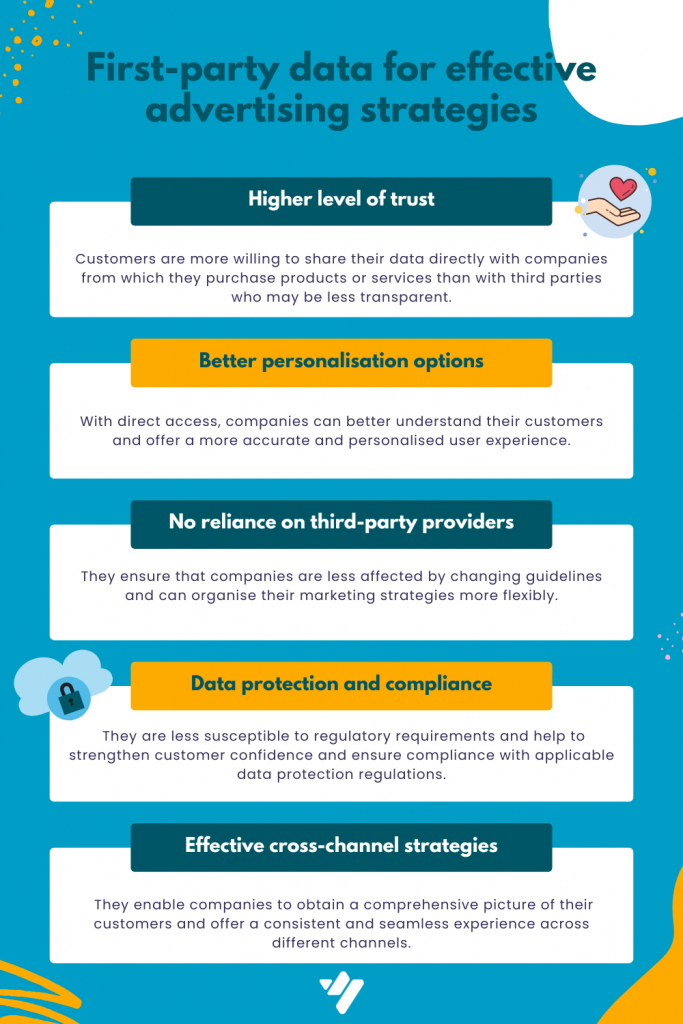With the planned phasing out of 3rd party cookies, the ongoing development of data protection in the digital space and the ever stricter requirements of the General Data Protection Regulation (GDPR), market players are increasingly faced with the challenge of developing effective solutions that meet the new standards. This paradigm shift also requires strategies and technologies to be adapted in order to fulfil the new requirements.
In this time of upheaval, agencies, advertisers and publishers are increasingly looking for alternatives that enable them to place personalised advertising while guaranteeing user privacy. One promising option, for example, is solutions based on first-party data, where advertisers and publishers can establish direct relationships with their target groups and obtain their consent to the use of data.
First-party data are primary sources of information that come from a variety of origins such as website visits, transaction histories, customer registrations and social media interactions.Unlike second- or third-party data, which comes from external sources or third-party providers, first-party data belongs to the company itself. This direct relationship with customers gives the data a high level of authenticity and enables publishers and agencies to use it effectively for their marketing purposes, as it is generally more accurate and up-to-date than data from third-party providers.In addition, by collecting first-party data, companies can be more transparent with usage and better comply with privacy policies, which increases consumer trust and reduces the risk of data breaches.
A recent study by the Interactive Advertising Bureau (IAB) also shows the major role that first-party data plays as an alternative to cookies. It shows that 71% of market participants are already expanding or planning to expand their first-party data sets – almost twice as many as two years ago (41%).
Using first-party data correctly
By analysing first-party data, companies can identify numerous segments within their target group, which enables them to develop customised advertising campaigns that are tailored to the individual needs and interests of users.By delivering relevant messages at the right time and through the right channel, advertisers can also increase the likelihood that their adverts will be noticed and positively received by consumers.
„However, to realise the full potential of first-party data, companies need to invest in the right technologies and analytics tools. In particular, implementing a data management platform (DMP) is essential for companies to effectively collect, organise and interpret data,“ says Anna Rossmanith, Team Lead Key Account Management at The Adex.
Rossmanith goes on to explain how DMPs can support the advertising activities of publishers and agencies: „The seamless linking of data across different devices through the integration of cross-device graphs and the ability to use lookalike models to help identify similar target groups can make a significant contribution to the effectiveness of marketing campaigns. In addition, our customers‘ data is stored and processed exclusively in Germany – i.e. without the use of cloud services or servers abroad – which further strengthens data protection and GDPR compliance.“

The time for alternatives is now
First-party data can therefore play a crucial role in the post-cookie era, especially in times when privacy protection and the regulation of data traffic are being stepped up.
However, in addition to first-party data, alternatives such as contextual targeting, unified ID solutions, data clean rooms or the Google Privacy Sandbox are sometimes good solutions that should be considered to prepare for the upcoming change while protecting user privacy.
Publishers as well as advertisers and agencies should look into possible alternatives, their requirements and possible applications until the 3rd party cookies are actually phased out in order to be able to continue running effective advertising campaigns. Which solution companies choose can be very individual and depends on internal requirements, infrastructures and objectives, among other things. The only important thing is that all market players deal with this paradigm shift now, because the course has already been set for the post-cookie era.